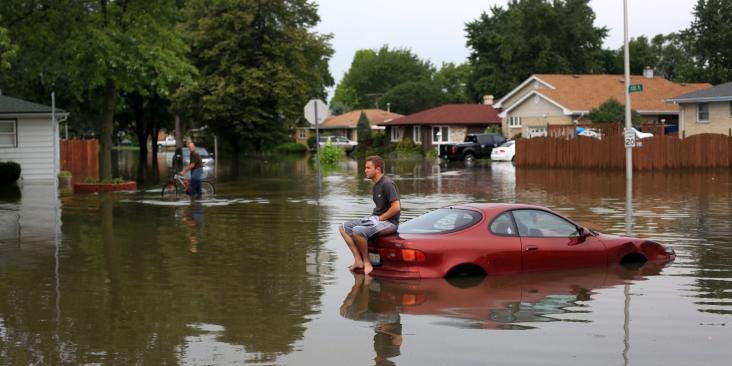What Is Climate Risk? And What Should Organizations Do About It?
Exploring climate risk, regulation, and reporting.
Climate risk refers to the potential negative impacts of climate change on society, ecosystems, and economic systems. As global temperatures rise, the risks we face are becoming increasingly complex, unpredictable, and widespread.
Climate risks are already proving to be harmful to both ecosystem health and human well-being, disrupting food systems, increasing the spread of disease, and threatening livelihoods across the globe. In this week’s newsletter, we discuss not only what climate risk is, but also why reporting on climate risk is important and how organizations can begin to prepare. We are also lucky to feature remarks from industry experts Dr. Funké Adeosun and Chris Bolman, who offer strategic insights into climate risk.
Why Does Assessing Climate Risk Matter?
Climate risk manifests in a variety of ways. Acute or short-term risks include sudden, severe weather events such as hurricanes, floods, and wildfires that can devastate communities, disrupt supply chains, and cripple infrastructure. On the other hand, chronic or long-term risks evolve more slowly but are equally destructive, including rising sea levels, prolonged droughts, desertification, and land degradation.
Additionally, compound risks (where multiple climate threats occur simultaneously or sequentially) can magnify impacts. For example, a flood followed by a heatwave may worsen the health impacts on already vulnerable populations. Non-linear effects, or where small changes trigger sudden, drastic consequences, are also becoming more common, making climate risk assessment a complex but vital endeavor.
“By evaluating, understanding, and reporting on climate risk, organizations are demonstrating they’re not only aware of emerging environmental challenges but are actively managing and responding to them.” - Chris Bolman, Co-Founder & CEO of Brightest
The Implications of Climate Change
The impact of climate risk is not hypothetical. Indeed, it is already affecting billions. According to the World Health Organization (WHO), 3.6 billion people currently live in areas that are highly susceptible to climate change1. Between 2030 and 2050, climate-related conditions are expected to cause an additional 250,000 deaths annually, stemming from undernutrition, malaria, diarrhoea, and heat stress alone.
Economic cost is another indicator of the scale of this issue. The World Economic Forum estimates that climate change could result in annual damages of US $1.7 trillion to US$3.1 trillion by 20502.
Indeed, the global financial ecosystem is already beginning to recognize the repercussions. Investors are integrating climate risk into decision-making processes, seeking to understand how future climate conditions could impact the performance of their portfolios. Governments, too, are responding with an array of policies and regulations requiring businesses to measure and disclose climate risks.
Types of Climate Risk
Understanding climate risk begins with recognizing its three main categories:
Physical Risks:
These include both acute and chronic effects of climate change, such as natural disasters or long-term shifts in weather patterns, that directly impact assets and operations.Transition Risks:
These stem from the shift to a low-carbon economy. New laws, market changes, or technological developments can render existing business models obsolete or increase compliance costs.Liability Risks:
Organizations may face legal actions if they are deemed to have contributed to climate change or failed to mitigate its effects. This includes lawsuits from governments, shareholders, or affected communities.
How Organizations Assess Climate Risk
To effectively manage climate risks, organizations must first assess them. This process involves identifying, analyzing, and quantifying how climate change could affect their assets, operations, and value chains.
Identifying Risks:
Companies must identify all relevant physical, transition, and liability risks. These vary depending on geography, industry, and organizational structure.Quantifying Impact:
Once risks are identified, organizations must evaluate their potential impact. This is often done in financial terms and includes estimating the cost of infrastructure damage, supply chain interruptions, or regulatory compliance.Scenario Analysis:
A cornerstone of climate risk assessment is scenario analysis, which uses climate models to explore different future climate trajectories and their associated risks. These scenarios allow companies to test the resilience of their strategies under various climate conditions.Social and Labor Considerations:
Risks are not limited to infrastructure or finance; they include the social impacts of climate change, such as labor availability, workforce health, and community stability.
Reporting on Climate Risk
As climate risk becomes a material concern, legislation is evolving to ensure greater transparency. Many jurisdictions now require companies to report on climate risk and how it is being managed. Notable examples include California’s SB 219, which mandates the disclosure of climate-related financial risks and greenhouse gas emissions. The International Sustainability Standards Board (ISSB) has introduced IFRS S2, a global baseline for climate disclosures. National regulations aligned with IFRS S2 are also being implemented in Australia, Japan, and the European Union.
“We're witnessing something massive when it comes to environmental legislation, not just for the insurance sector, but for every sector globally where business is happening. A lot of the regulation is geared towards reporting, but it's more about embedding climate risk into core governance, capital planning, and long-term strategy.” - Dr. Funké Adeosun, Head of Global Sustainability Solutions Practice at Allianz Commercial
The benefits of climate risk reporting are multifaceted. Enhanced transparency demonstrates accountability and fosters trust among stakeholders. Compliance with evolving regulations enables companies to remain ahead of legal requirements. Clear communication of climate strategies boosts investor confidence, particularly among those prioritizing sustainability. Furthermore, showcasing leadership in climate responsibility strengthens brand reputation and customer loyalty.
“Sustainability isn't just a moral imperative; it's a strategic advantage. When businesses embed environmental and social responsibility into their core, they don't just reduce risk. They unlock innovation, build resilience, and create lasting value for stakeholders and shareholders alike."- Chris Bolman, Co-Founder & CEO of Brightest
Strategies for Climate Risk Mitigation
Mitigating climate risk involves adapting to unavoidable changes while addressing the root causes of climate disruption. One key approach is transitioning away from fossil fuels by investing in renewable energy sources such as solar, wind, and hydro, which reduces dependence on carbon-intensive energy and aligns with global emissions targets. Environmental protection and sustainable land use also play a crucial role; preserving forests, restoring wetlands, and encouraging regenerative agriculture bolster ecosystem resilience and enhance carbon sequestration.
Infrastructure must be climate-resilient. This involves designing buildings and systems capable of withstanding extreme weather and shifting environmental conditions, including energy-efficient structures, advanced flood defenses, and smart energy grids. Policy support and advocacy are essential to ensure climate considerations are integrated into governance and decision-making processes at all levels.
“It's about making sure that that business is sustainable for the future and thinking about what is going to happen in ten years, 20 years, 30 years, 40 years, 50 years, not what's going to happen at the end of this period or this quarter.” -Dr. Funké Adeosun, Head of Global Sustainability Solutions Practice at Allianz Commercial
Interorganizational collaboration is another critical strategy. Partnerships between public and private sectors, industry alliances, and cross-sector initiatives allow for shared knowledge and pooled resources, leading to broader and more effective action. Additionally, green financial tools such as green bonds, sustainability-linked loans, and climate-focused investment funds offer financial incentives that drive sustainable innovation and planning.
Building Resilience in a Changing Climate
Climate risk is not a future concern; it is a current and escalating reality. Its implications are broad, affecting everything from public health to corporate bottom lines. Organizations that proactively assess, report, and mitigate climate risks will not only protect their operations but also position themselves as leaders in the transition to a sustainable economy. Understanding climate risk is the first step. Acting on that understanding is now a necessity.
As climate science evolves and as new technologies and policy frameworks emerge, the ability to adapt and respond will define the resilience and success of organizations, communities, and nations in the years to come.
Interested in learning more about climate risk? Industry experts Dr. Funké Adeosun and Chris Bolman will be discussing this important topic during an exclusive webinar on climate risk and reporting, and climate risk mitigation strategies on June 6th.
This Week in Sustainability is a weekly email from Brightest (and friends) about sustainability and climate strategy. If you’ve enjoyed this piece, please consider forwarding it to a friend or teammate. If you’re reading it for the first time, we hope you enjoyed it enough to consider subscribing. If we can be helpful to you or your organization’s sustainability journey, please be in touch.













